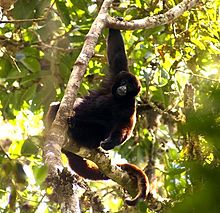Oreonax
| Yellow-tailed woolly monkey | |
|---|---|
 |
|
| Scientific classification | |
| Kingdom: | Animalia |
| Phylum: | Chordata |
| Class: | Mammalia |
| Order: | Primates |
| Family: | Atelidae |
| Genus: |
Oreonax Thomas, 1927 |
| Species: | O. flavicauda |
| Binomial name | |
|
Oreonax flavicauda (Humboldt, 1812) |
|
 |
|
| Geographic range | |
| Synonyms | |
|
Lagothrix flavicauda Humboldt, 1812 Lagothrix hendeei Thomas, 1927 |
|
Lagothrix flavicauda Humboldt, 1812 Lagothrix hendeei Thomas, 1927
The yellow-tailed woolly monkey (Oreonax flavicauda) is a New World monkey endemic to Peru. It is a rare primate species found only in the Peruvian Andes, in the departments of Amazonas and San Martin, as well as bordering areas of La Libertad, Huánuco, and Loreto. The yellow-tailed woolly monkey was at first under the Lagothrix genus along with other woolly monkeys, but due to debatable primary sources, they have been placed in Oreonax. Oreonax has been proposed to be a subgenus of Lagothrix, but others have acknowledged it to be a full genus. A recent extensive study proves that the yellow-tailed woolly monkey may indeed be in Lagothrix.
The species was first described by Alexander von Humboldt in 1812 under the name Simia flavicauda, based on a skin found 10 years earlier, used by a local man as a horse saddle. Humboldt had never seen a live animal of this species nor a preserved specimen, and believed it belonged to the genus Alouatta. For over 100 years, the species was reported on only a few isolated occasions, so was thought to be extinct.
In 1926, three specimens were collected in San Martin, which were then brought to the Museum of Natural History. They were believed to be of a new species, but further evidence made it clear that these specimens were of the yellow-tailed woolly monkey.
In 1974, a group of scientists, led by Russell Mittermeier, and funded by World Wide Fund for Nature, found a young yellow-tailed woolly monkey which was kept as a pet in the city of Pedro Ruiz Gallo, Amazonas. The rediscovery attracted the attention of national and international press, as well as conservation organizations that saw the need to know quickly the status of this species.
...
Wikipedia

